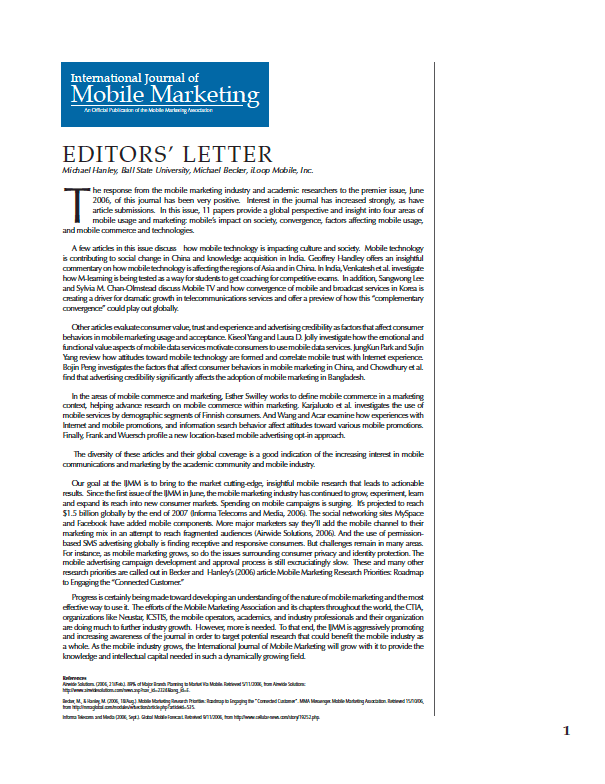Coauthored by Michael Hanley and Michael Becker
The response from the mobile marketing industry and academic researchers to the premier issue, June. 2006, of this journal, has been very positive. Interest in the journal has increased strongly, as have article submissions. In this issue, 11 papers provide a global perspective and insight into four areas of mobile usage and marketing: mobile’s impact on society, convergence, factors affecting mobile usage, and mobile commerce and technologies.
A few articles in this issue discuss how mobile technology is impacting culture and society. Mobile technology is contributing to social change in China and knowledge acquisition in India. Geoffrey Handley offers an insightful commentary on how mobile technology is affecting the regions of Asia and in China. In India, Venkatesh et al. investigate how M-learning is being tested as a way for students to get coaching for competitive exams. In addition, Sangwong Lee and Sylvia M. Chan-Olmstead discuss Mobile TV and how the convergence of mobile and broadcast services in Korea is creating a driver for dramatic growth in telecommunications services and offer a preview of how this “complementary convergence” could play out globally.

Other articles evaluate consumer value, trust and experience and advertising
credibility as factors that affect consumer behaviors in mobile marketing usage
and acceptance. Kiseol Yang and Laura D. Jolly investigate how the emotional
and functional value aspects of mobile data services motivate consumers to use
mobile data services. JungKun Park and SuJin Yang review how attitudes toward
mobile technology are formed and correlate mobile trust with Internet
experience. Bojin Peng investigates the factors that affect consumer behaviors
in mobile marketing in China, and Chowdhury et al. find that advertising
credibility significantly affects the adoption of mobile marketing in
Bangladesh. In the areas of mobile commerce and marketing, Esther Swilley works
to define mobile commerce in a marketing context, helping advance research on
mobile commerce within marketing. Karjaluoto et al. investigates the use of mobile
services by demographic segments of Finnish consumers. And Wang and Acar
examine how experiences with Internet and mobile promotions, and information
search behavior affect attitudes toward various mobile promotions. Finally,
Frank and Wuersch profile a new location-based mobile advertising opt-in
approach. The diversity of these articles and their global coverage is a good
indication of the increasing interest in mobile communications and marketing by
the academic community and mobile industry.
Our goal at the IJMM is to bring to the market cutting-edge, insightful mobile research that leads to actionable results. Since the first issue of the IJMM in June, the mobile marketing industry has continued to grow, experiment, learn and expand its reach into new consumer markets. Spending on mobile campaigns is surging. It’s projected to reach $1.5 billion globally by the end of 2007 (Informa Telecoms and Media, 2006). The social networking sites MySpace and Facebook have added mobile components. More major marketers say they’ll add the mobile channel to their marketing mix in an attempt to reach fragmented audiences (Airwide Solutions, 2006). And the use of permissionbased SMS advertising globally is finding receptive and responsive consumers. But challenges remain in many areas. For instance, as mobile marketing grows, so do the issues surrounding consumer privacy and identity protection. The mobile advertising campaign development and approval process is still excruciatingly slow. These and many other research priorities are called out in Becker and Hanley’s (2006) article Mobile Marketing Research Priorities: Roadmap to Engaging the “Connected Customer.”
Progress is certainly being made toward developing an understanding of the nature of mobile marketing and the most effective way to use it. The efforts of the Mobile Marketing Association and its chapters throughout the world, the CTIA, organizations like Neustar, ICSTIS, the mobile operators, academics, and industry professionals and their organization are doing much to further industry growth. However, more is needed. To that end, the IJMM is aggressively promoting and increasing awareness of the journal in order to target potential research that could benefit the mobile industry as a whole. As the mobile industry grows, the International Journal of Mobile Marketing will grow with it to provide the
knowledge and intellectual capital needed in such a dynamically growing field.
References
Airwide Solutions. (2006, 21//Feb.). 89% of Major Brands Planning to Market Via Mobile. Retrieved 5/11/2006, from Airwide Solutions:
Becker, M., & Hanley, M. (2006, 18/Aug.). Mobile Marketing Research Priorities: Roadmap to Engaging the “Connected Customer”. MMA Messenger. Mobile Marketing Association. Retrieved 15/10/06,
from http://mmaglobal.com/modules/wfsection/article.php?articleid=535.
Informa Telecoms and Media (2006, Sept.). Global Mobile Forecast. Retreived 9/11/2006, from http://www.cellular-news.com/story/19252.php.

No Comments.